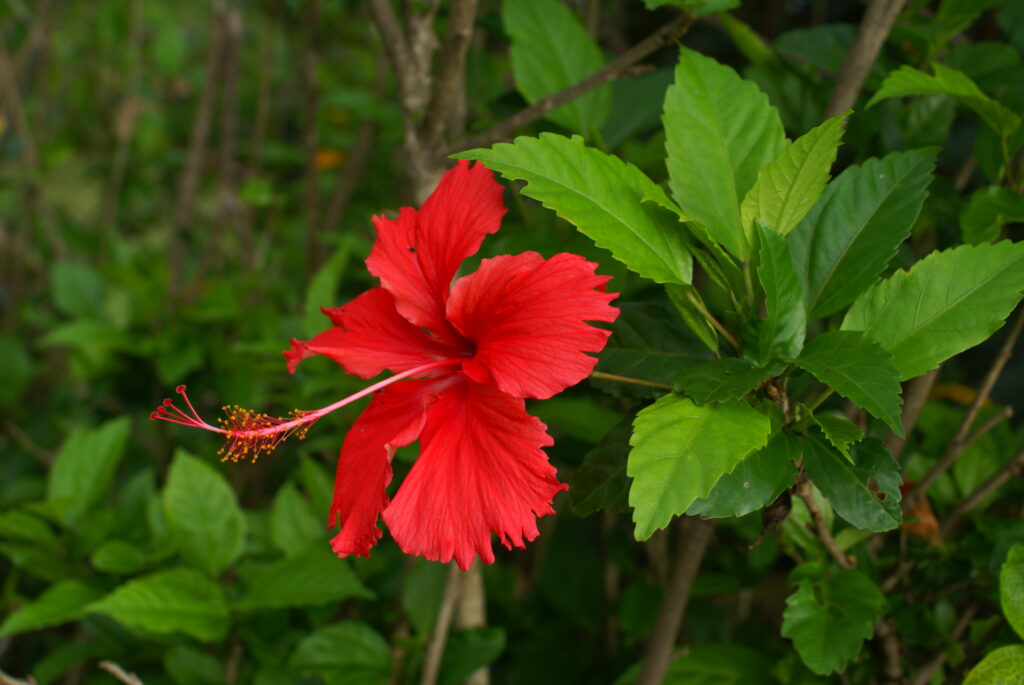
B.navez, from Wikimedia, CC BY-SA 4.0
Saint Martin
Hibiscus
Hibiscus

B.navez, from Wikimedia, CC BY-SA 4.0
General Description / Cultural Significance
Hibiscus (Hibiscus) flowers are large, showy, Hibiscus (Hibiscus) is a striking flowering plant known for its large, vibrant blooms, which come in an array of colors, including red, pink, orange, yellow, and white. The flowers are typically broad and trumpet-shaped, with delicate, overlapping petals that exude a sweet, floral, and subtly tart aroma. A key identifying feature of the hibiscus is its prominent light orange central pistil, which extends well beyond the petals, giving the flower a distinctive and elegant appearance.
Hibiscus species vary in form, with some growing as shrubs, herbs, or small trees, reaching up to 15 feet in height. These plants thrive in warm, tropical climates, making them well-suited to the environment of Saint Martin. The island’s climate provides the ideal conditions for hibiscus to flourish, and as a result, the plant is a common sight in home gardens, public parks, and along roadsides, adding bursts of color to the landscape.
Beyond its ornamental appeal, hibiscus holds cultural and practical significance in Saint Martin and across the Caribbean. The dried petals of certain species, particularly Hibiscus sabdariffa (also known as roselle), are commonly used to make hibiscus tea, a refreshing and tangy herbal infusion rich in antioxidants. This tea is enjoyed both hot and cold and is sometimes sweetened with sugar or honey. Additionally, hibiscus is used in the preparation of jams, syrups, and desserts, adding a floral and mildly citrusy note to local cuisine.
Hibiscus also plays an important role in traditional medicine. In Caribbean herbal practices, it is valued for its purported health benefits, including its ability to help lower blood pressure, support liver function, improve skin health, and act as an anti-inflammatory agent. Its natural acids and mucilaginous properties make it a common ingredient in homemade hair and skin treatments, believed to promote hair growth and hydrate the skin.
Climate Change / Conservation Status
Hibiscus is not currently classified as a threatened or endangered species in Saint Martin. It is widely cultivated and has become naturalized in many tropical and subtropical regions worldwide. However, climate change presents potential challenges to hibiscus cultivation in the long term. Rising temperatures, prolonged droughts, and shifting rainfall patterns could affect the plant’s growth cycle, alter blooming periods, and reduce flower production. Additionally, extreme weather events, such as hurricanes and tropical storms, pose a threat to hibiscus populations, particularly in coastal areas where strong winds and saltwater intrusion can damage plants.
While hibiscus remains resilient and adaptable, conservation efforts should focus on promoting sustainable gardening practices, preserving native pollinators that contribute to hibiscus propagation, and mitigating environmental stressors that could impact its abundance. Encouraging local cultivation, maintaining biodiversity, and protecting natural habitats will help ensure that hibiscus continues to thrive in Saint Martin’s changing climate.
Alternate Names
Roselle (Hibiscus sabdariffa): Used for making hibiscus tea, popular in the Caribbean, Africa, and Latin America.
Sorrel: A common name in the Caribbean, especially for hibiscus tea during festive seasons…
Rose Mallow: A name referring to various hibiscus species, particularly in North America.
Sources
Shanazz, Khadijah. “The Hibiscus Flower in Caribbean Culture and Jewelry.” Caribbijou Island Jewellery, Caribbijou Island Jewellery, caribbijou.com/blogs/news/the-hibiscus-flower-in-caribbean-culture-and jewelry.
Sottosanti, Karen. “Hibiscus.” Encyclopædia Britannica, Encyclopædia Britannica, inc., 2024, www.britannica.com/plant/hibiscus.

